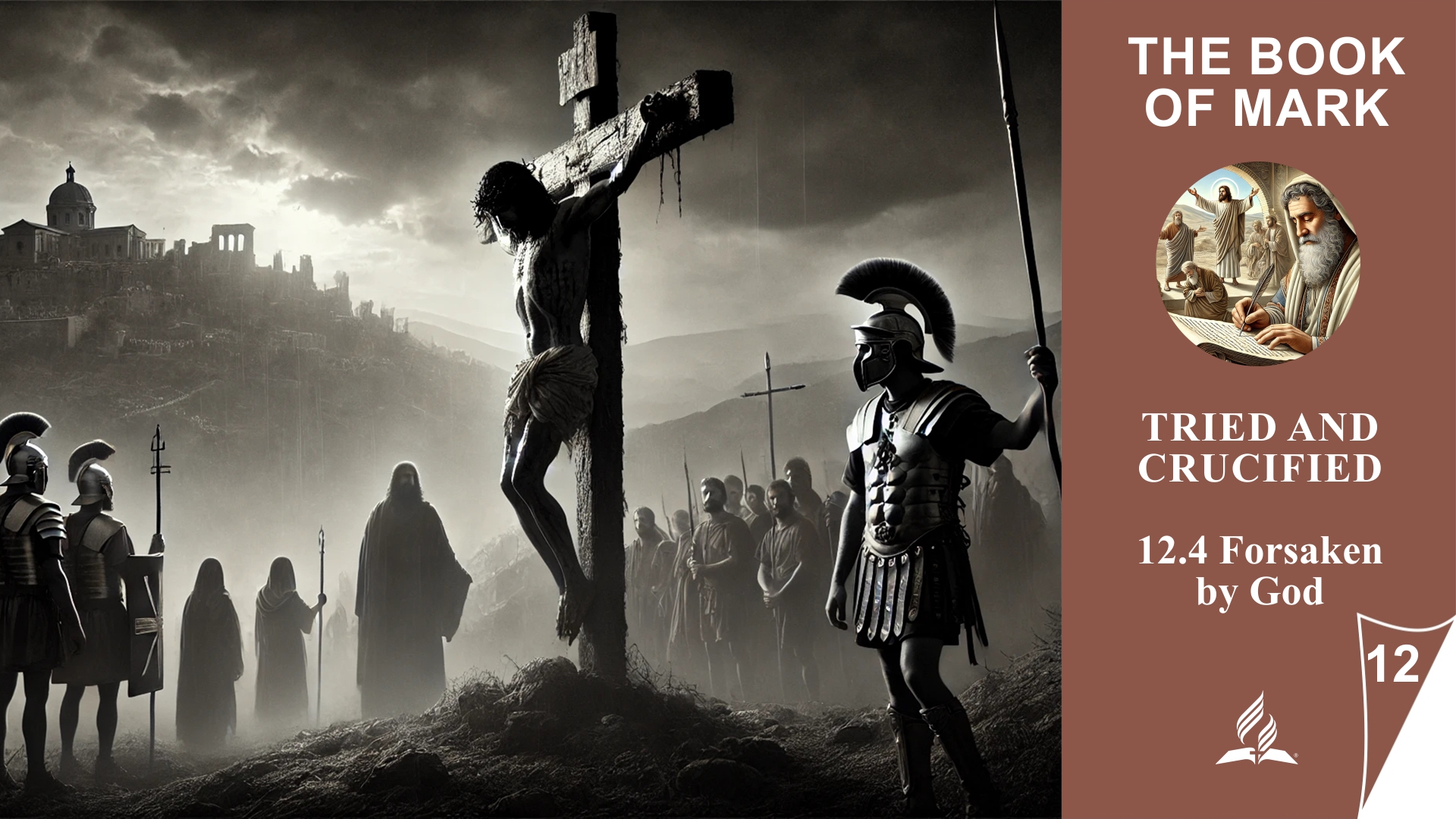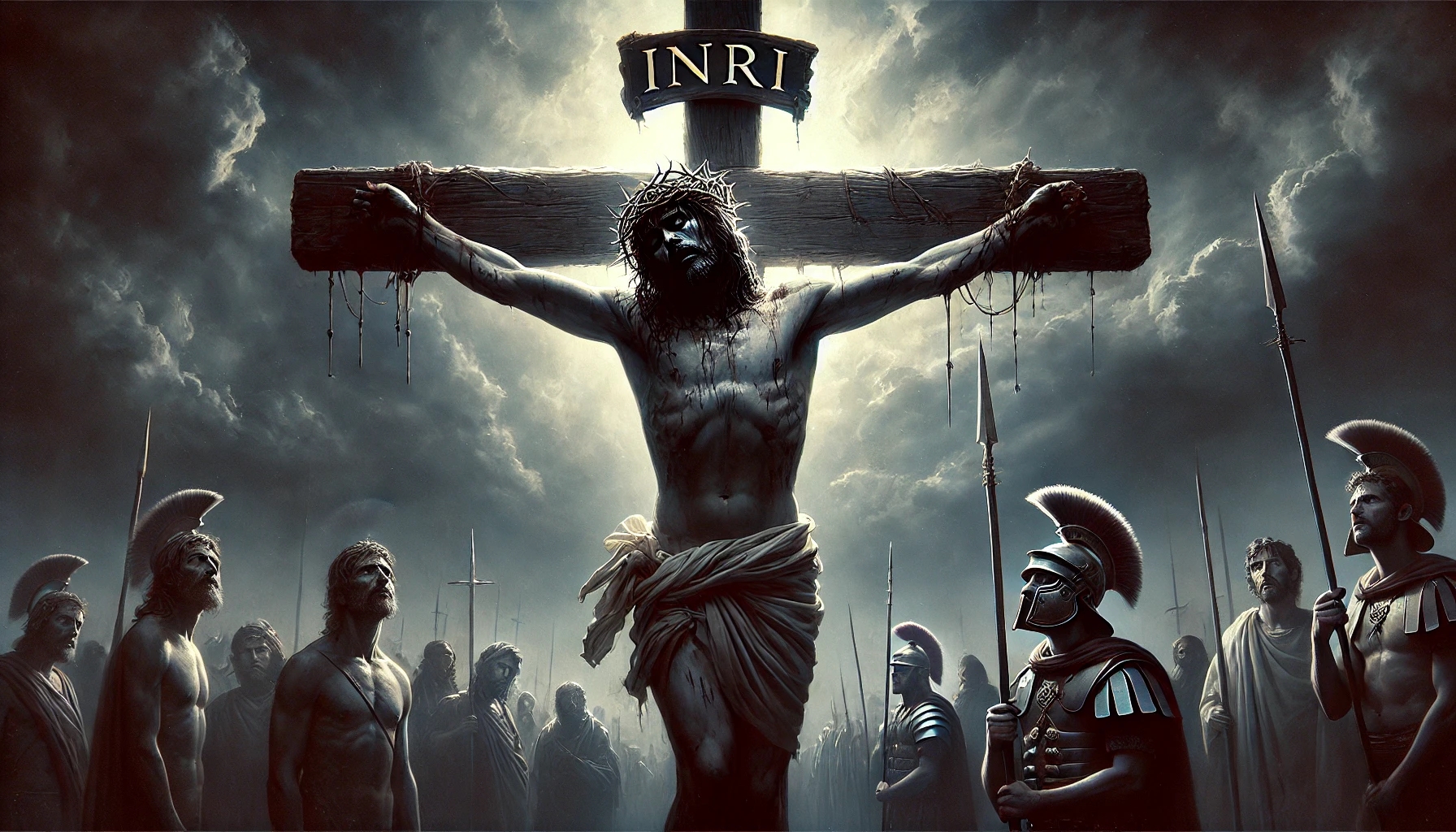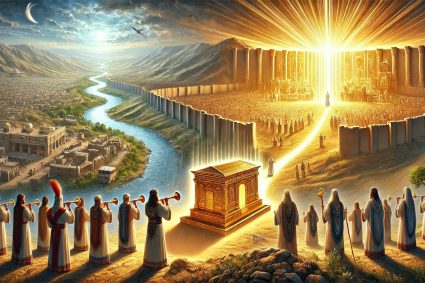


12.4 Forsaken by God
The Cry of Abandonment: Jesus’ Death as the Key to Redemption
Read Mark 15:33–41. What were Jesus’ only words on the cross in the Gospel of Mark? What does Christ’s death ultimately mean for all of us?
In Mark 15:33–41, we read Jesus’ last words on the cross: “My God, my God, why have you forsaken me?” (Mark 15:34). These words, also known as the “Cry of Abandonment,” express the deep suffering and isolation that Jesus experienced in that moment. Jesus quotes Psalm 22:2, indicating that His death is not just a moment of despair but the fulfillment of Scripture. Even in the darkest moment, God’s plan is unfolding.
-
The Meaning of Abandonment
The “Cry of Abandonment” reveals the deepest human experience of Jesus: separation from God. This moment symbolically represents the burden of the world’s sins that Jesus has taken upon Himself. In this abandonment, Jesus bears the full weight of sin and separates Himself—albeit temporarily—from the immediate fellowship with the Father to redeem humanity. His abandonment is a necessary part of the redemptive work, as Jesus takes upon Himself the judgment of sin on our behalf.
-
The Fulfillment of the Divine Plan
Although Jesus’ death on the cross appears to be a defeat, Mark shows that through this act, God’s plan is fulfilled. The dark hours and the tearing of the temple curtain (Mark 15:38) indicate that Jesus’ sacrifice initiates a new phase of redemption. The old sacrificial system is replaced by Jesus’ ultimate sacrifice, and the curtain that symbolized the separation between God and humanity is removed. This opens the way to God for all people.
-
The Parallels Between Baptism and the Cross
The parallels between Jesus’ baptism and His crucifixion show that His ministry, which began with baptism, reaches its climax at the cross. Just as the heavens opened at His baptism, the temple curtain is torn at the cross, and while God’s voice called Jesus the “beloved Son” at baptism, the Roman centurion at the cross declares that Jesus is the “Son of God.” These parallels underscore that Jesus’ death is the culmination of His mission—He dies as a ransom for many (Mark 10:45).
-
The Beginning of a New Phase of Redemption
The tearing of the temple curtain is a symbolic act that shows the old covenant sacrificial system is fulfilled. With Jesus’ death, direct access to God is made possible. The separation between God and humanity caused by sin is abolished through Jesus’ death. A new era of redemption begins, where people are saved not through sacrifices in the temple but through faith in Christ’s sacrifice.
-
Suffering as Part of the Divine Plan
Jesus’ path of suffering and the physical agony He endures on the cross fulfill the prophetic scriptures (cf. Psalm 22). The unimaginable pain He endures—the nails through His wrists, the suffocating sensation when raising His body—is not only a demonstration of human cruelty but also part of the divine plan for redemption. Jesus’ willingness to suffer shows that true love and dedication know no bounds.
Conclusion
Jesus’ words on the cross, “My God, my God, why have you forsaken me?” express the depth of His suffering and abandonment He bore to redeem humanity. However, His death is not the end but the beginning of a new phase of redemption. Through His sacrifice on the cross, access to God is made possible for all people, and Jesus’ abandonment leads to reconciliation between God and humanity.
Despite the evil machinations of humans, God’s intentions were fulfilled. Why should this help us learn that, no matter what is happening around us, we can still trust God and know that His goodness will ultimately triumph?
The crucifixion of Jesus powerfully demonstrates that even in the darkest moments, where it seems that evil machinations and human wickedness are triumphing, God’s plan is still being fulfilled. The example of Jesus’ crucifixion and resurrection teaches us that God’s intentions and His goodness will ultimately prevail, even when circumstances appear hopeless.
-
God’s Plan Overcomes Human Failure
The religious leaders and Roman authorities thought they had the upper hand by condemning and crucifying Jesus. However, this apparent defeat was part of God’s plan for the redemption of humanity. This shows us that God’s plan is often greater than we can understand in difficult moments. Even when people do evil or we find ourselves in challenging situations, God remains sovereign and brings His intentions to fruition.
-
Trusting in God’s Control
Knowing that God’s plans cannot be thwarted gives us security. Even when our circumstances are chaotic, painful, or confusing, we can trust that God remains in control. Just as Jesus seemed abandoned and defeated on the cross, we know today that this was the beginning of the victory over death. In our own life experiences, we can trust in God’s sovereign power, which brings good out of evil intentions (Romans 8:28).
-
God’s Goodness Will Triumph in the End
Jesus’ resurrection proves that God’s goodness will ultimately triumph, no matter how bleak the circumstances. Even death could not stop God’s love and goodness. When we look to the promise of the resurrection, we learn that we can hope for God’s ultimate intervention in times of need, suffering, or confusion. His victory over evil and death assures us that His goodness will have the final word.
-
Faith in Difficult Times
In difficult times, it is often hard to recognize God’s work. However, the story of the crucifixion teaches us that God often works behind the scenes and fulfills His plans in ways we do not immediately understand. When we look at Jesus’ crucifixion and resurrection, we can learn to trust in God’s goodness amidst chaos and pain, remembering that He is always with us and has a plan for our lives.
Conclusion
The crucifixion of Jesus shows us that God’s goodness and plan cannot be thwarted despite evil machinations and human wickedness. No matter how dark our circumstances may be, we can trust that God is working everything for good. His love and goodness will ultimately triumph, and this trust gives us hope and strength to remain steadfast even in difficult times.
The connection between Jesus’ “Cry of Abandonment” on the cross and our daily lives as well as our faith lies in the profound message of trust and hope amidst suffering and despair.
-
Experiencing Abandonment in Daily Life
Just as Jesus felt abandoned by God on the cross, there are moments in our lives when we feel abandoned, helpless, or distant from God. These times can be especially difficult when we face loss, pain, or uncertainty. However, Jesus’ words on the cross remind us that even in the darkest moments, God’s plan is still unfolding. His “Cry of Abandonment” shows that even the Son of God experienced moments of despair—a sign that God understands our suffering.
-
Trusting in God’s Greater Plans
Jesus’ death on the cross may have seemed like a defeat, but in reality, it was the greatest victory—the redemption of humanity. Similarly, in difficult times, we often cannot see the purpose or end of our suffering. However, Christ’s death teaches us that God’s plans are often hidden, and we can trust that He is leading everything towards good, even if it does not seem so at the moment. This lesson is especially valuable when we feel that our lives are out of control or that evil intentions are prevailing over us.
-
The Victory of Divine Goodness
Jesus’ death and resurrection show that God’s goodness will ultimately triumph, no matter how dark the circumstances are. For our daily lives, this means that we can always trust in God’s goodness in difficult situations. Even when we question why God seemingly abandoned us in moments of trial or suffering, we can know that His love is stronger than anything that happens to us.
-
Hope in Dark Times
The darkness that fell over the land during Jesus’ crucifixion symbolizes times when we find ourselves in spiritual or emotional darkness. However, just as this darkness at the cross was not the end, darkness in our lives is never the final chapter. Jesus’ resurrection shows that behind the darkness, hope and new life await. This gives us the confidence in our daily lives to trust in God’s light, even in the most challenging phases.
Conclusion
Jesus’ “Cry of Abandonment” and His death on the cross teach us that God never truly abandons us, even when we do not feel His presence. His plan for redemption triumphed even in the darkest hours, and we can apply this truth to our lives. No matter how difficult our circumstances are, God’s goodness will ultimately prevail, and we can walk through tough times with trust and hope, knowing that we are not alone.
True strength is shown in trusting God’s plan even in times of abandonment.
Visited 59 times, 1 visit(s) today








